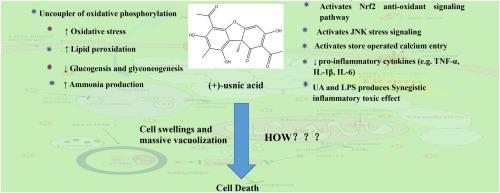Environmental Toxicology and Pharmacology ( IF 4.3 ) Pub Date : 2020-09-19 , DOI: 10.1016/j.etap.2020.103493 Sukfan P Kwong 1 , Changhong Wang 1

|
Increasing prevalence of herbal and dietary supplement-induced hepatotoxicity has been reported worldwide. Usnic acid (UA) is a well-known hepatotoxin derived from lichens. Since 2000, more than 20 incident reports have been received by the US Food and Drug Administration after intake of UA containing dietary supplement resulting in severe complications. Scientists and clinicians have been studying the cause, prevention and treatment of UA-induced hepatotoxicity. It is now known that UA decouples oxidative phosphorylation, induces adenosine triphosphate (ATP) depletion, decreases glutathione (GSH), and induces oxidative stress markedly leading to lipid peroxidation and organelle stress. In addition, experimental rat liver tissues have shown massive vacuolization associated with cellular swellings. Additionally, various signaling pathways, such as c-JNK N-terminal kinase (JNK), store-operated calcium entry, nuclear erythroid 2-related factor 2 (Nrf2), and protein kinase B/mammalian target of rapamycin (Akt/mTOR) pathways are stimulated by UA causing beneficial or harmful effects. Nevertheless, there are controversial issues, such as UA-induced inflammatory or anti-inflammatory responses, cytochrome P450 detoxifying UA into non-toxic or transforming UA into reactive metabolites, and unknown mechanism of the formation of vacuolization and membrane pore. This article focused on the previous and latest comprehensive putative mechanistic findings of UA-induced hepatotoxicity and cell death. New insights on controversial issues and future perspectives are also discussed and summarized.
中文翻译:

评论:松萝酸诱导的肝毒性和细胞死亡。
全世界已经报道了由草药和膳食补充剂引起的肝毒性的患病率增加。松萝酸(UA)是一种衍生自地衣的著名肝毒素。自2000年以来,美国食品和药物管理局在摄入含有UA的膳食补充剂后导致严重并发症的事件已收到20多次。科学家和临床医生一直在研究UA诱导的肝毒性的原因,预防和治疗。现在已知UA使氧化磷酸化解偶联,诱导三磷酸腺苷(ATP)消耗,减少谷胱甘肽(GSH),并诱导明显导致脂质过氧化和细胞器应激的氧化应激。此外,实验性大鼠肝脏组织已显示出与细胞肿胀相关的大量空泡。此外,各种信号通路 UA会刺激诸如c-JNK N末端激酶(JNK),钙离子操纵的钙进入,核红系2相关因子2(Nrf2)和雷帕霉素的蛋白激酶B /哺乳动物靶标(Akt / mTOR)通路有利或有害的影响。然而,仍然存在争议性问题,例如UA引起的炎症或抗炎反应,细胞色素P450使UA解毒成无毒的UA或将UA转化成反应性代谢物以及空泡化和膜孔形成的未知机制。本文着重于UA诱导的肝毒性和细胞死亡的先前和最新的综合推定机制发现。还讨论和总结了关于有争议的问题和未来观点的新见解。UA刺激蛋白激酶B /雷帕霉素的哺乳动物靶标(Akt / mTOR)通路产生有益或有害作用。然而,仍然存在争议性问题,例如UA引起的炎症或抗炎反应,细胞色素P450使UA解毒成无毒的UA或将UA转化成反应性代谢物以及空泡化和膜孔形成的未知机制。本文着重于UA诱导的肝毒性和细胞死亡的先前和最新的综合推定机制发现。还讨论和总结了关于有争议的问题和未来观点的新见解。UA刺激蛋白激酶B /雷帕霉素的哺乳动物靶标(Akt / mTOR)通路产生有益或有害作用。然而,仍然存在争议性问题,例如UA引起的炎症或抗炎反应,细胞色素P450使UA解毒成无毒的UA或将UA转化成反应性代谢物以及空泡化和膜孔形成的未知机制。本文着重于UA诱导的肝毒性和细胞死亡的先前和最新的综合推定机制发现。还讨论和总结了关于有争议的问题和未来观点的新见解。例如UA诱导的炎症或抗炎反应,细胞色素P450将UA解毒为无毒或将UA转化为反应性代谢产物,以及形成空泡和膜孔的未知机制。本文着重于UA诱导的肝毒性和细胞死亡的先前和最新的综合推定机制发现。还讨论和总结了关于有争议的问题和未来观点的新见解。例如UA诱导的炎症或抗炎反应,细胞色素P450将UA解毒为无毒或将UA转化为反应性代谢产物,以及形成空泡和膜孔的未知机制。本文着重于UA诱导的肝毒性和细胞死亡的先前和最新的综合推定机制发现。还讨论和总结了关于有争议的问题和未来观点的新见解。


























 京公网安备 11010802027423号
京公网安备 11010802027423号